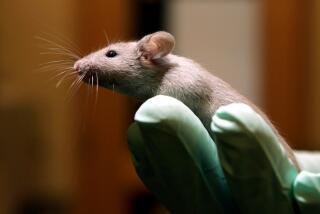Special Mice Developed for Testing AIDS Drugs : Research: A new Palo Alto company has successfully implanted human immune systems in rodents and then injected them with AIDS. Researchers then successfully treated the mice with the drug AZT.
- Share via
Researchers at a new Palo Alto company have demonstrated for the first time that a strain of mice with human immune systems can be used as a rapid and effective preliminary screen for new drugs against AIDS.
Immunologist J. Mike McCune and his colleagues at SyStemix Inc. report in today’s Science magazine that they have closely reproduced in the mice the effect of the drug AZT in humans, indicating the mice represent a comparatively inexpensive animal model for the disease. Such drugs cannot be tested in normal mice because the animals are not susceptible to infection by the AIDS virus, known as HIV.
The new mouse system can accelerate the development of new drugs for AIDS. Potential new drugs can readily be screened in the mice, in which components of a human immune system have been surgically implanted, to compare their efficacy to that of AZT, to eliminate those drugs that are ineffective and to indicate which are the most promising for human trials, McCune said.
That testing will enable pharmaceutical companies to eliminate ineffective drugs early in the development process. SyStemix, founded only a year ago, has already begun offering such screening on a contract basis.
“This model system is extremely valuable,” said Jack McGowan, who is in charge of new AIDS drug development at the National Institute of Allergy and Infectious Diseases in Bethesda, Md. “We haven’t had an animal model system to evaluate drugs against HIV. Now we do.”
Other Uses of Mice
Chimpanzees, the only animals that naturally develop an AIDS-like disease, are too scarce and expensive to be used for widespread testing of potential AIDS drugs.
The mice should also be useful for solving a number of problems that can’t be readily addressed in clinical trials in humans, McGowan added.
Such issues include: determining the optimum dose level for AZT and other drugs; determining whether a drug will prevent fetuses from contracting AIDS from infected mothers; testing combinations of drugs; and determining whether drugs like AZT can prevent infection in health care workers and police exposed to AIDS by needle sticks or bites.
The animals could even be useful in testing potential new AIDS vaccines, he added.
The key to the new development was the production of the special mice, called SCID-hu, by Stanford University immunologist Irving L. Weissman, McCune, who was then at Stanford, and their colleagues in late 1988.
They began with a strain of mice suffering from a genetic impairment called severed combined immunodeficiency disease (SCID), which leaves its victims without a functioning immune system and therefore highly susceptible to infection.
Using special surgical techniques, they implanted fetal human liver, thymus and lymph node glands into the mice. As these tissues mature, they form an intact human immune system that is capable of protecting the mice from infectious diseases.
The Stanford group then demonstrated that the mice could be infected with HIV.
Within two weeks after the SCID-hu mice are injected with HIV, the human tissues are all infected by the virus, while the animal’s own tissues remain uninfected, McCune and his colleagues report today.
But if the animals are given AZT in their drinking water the day before the HIV infection and that dosage is continued, the animals show no overt signs of infection two weeks later. “AZT is a fine drug, but we were surprised it worked so well,” McCune said in an interview.
If these animals stopped receiving the drug, however, they then became infected, indicating the virus was hiding somewhere in the body.
One immediate conclusion from the study, he added, is that AZT must be used in combination with other drugs to eradicate HIV from the body.
The AZT study was not financed by Burroughs-Wellcome, which manufactures AZT. SyStemix financed the study and the national institute furnished the drug. The company has already studied another promising AIDS drug called DDI in the same fashion, but McCune would not comment on the results until they are published in journals.
Dosage Questions
It is likely the national institute will contract with SyStemix in the future to screen other drugs and to answer some of the questions about AZT dosage and administration, company officials speculated.
But the company’s main hopes lie with pharmaceutical companies that are developing new AIDS drugs, said President David Rubinfien. “We’ve already talked with 50 to 60 companies worldwide, and a number are interested in working with us,” he said.
The company is opening a new research facility in Palo Alto in March, he said, and hopes to have several contracts in hand by then.






